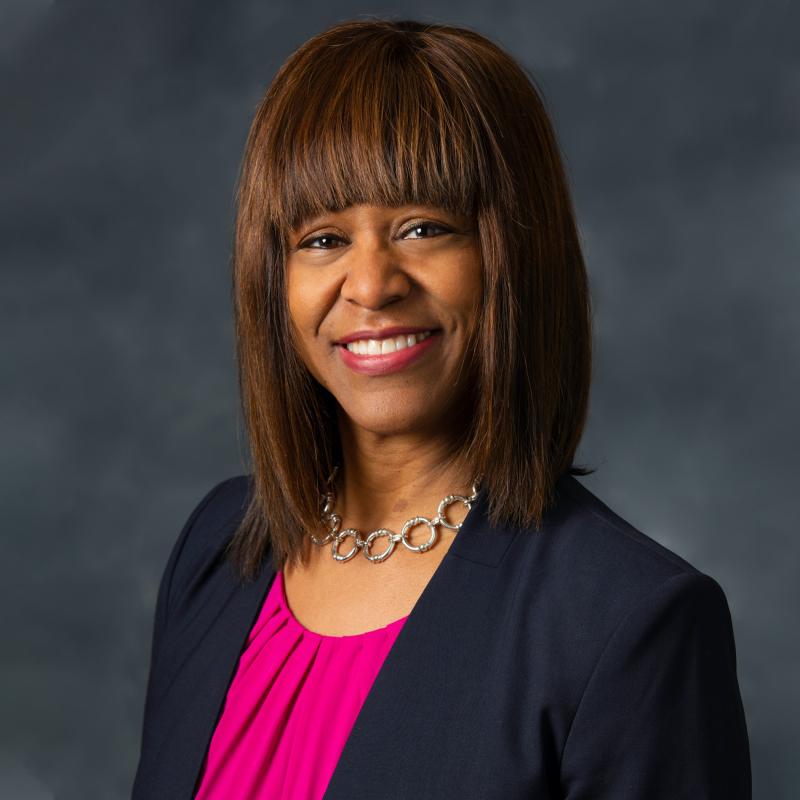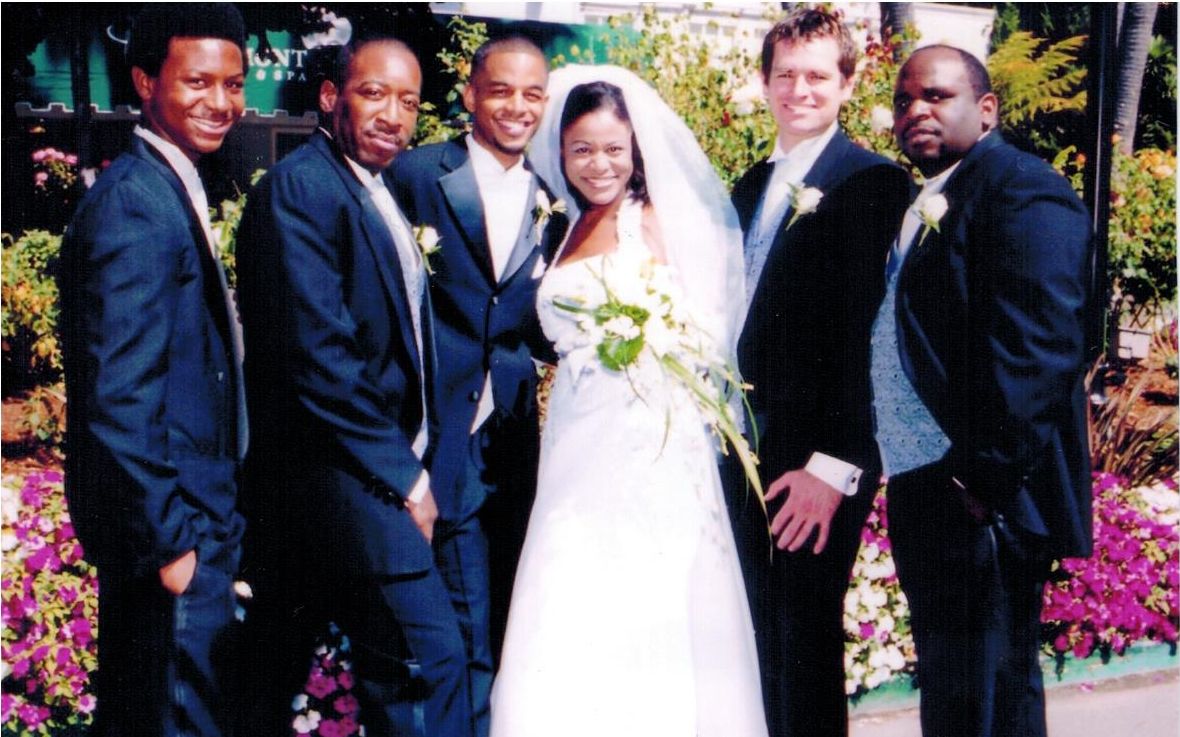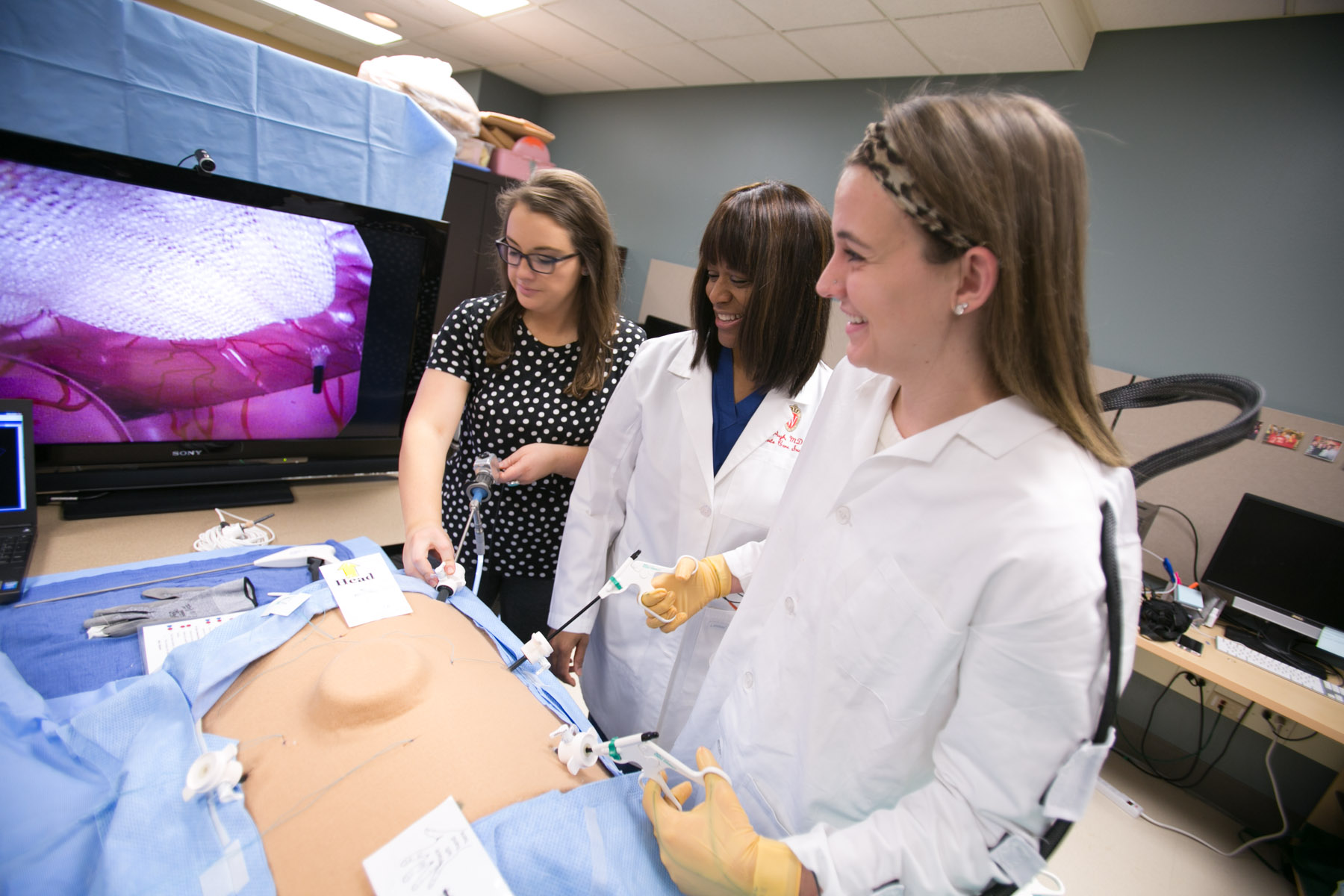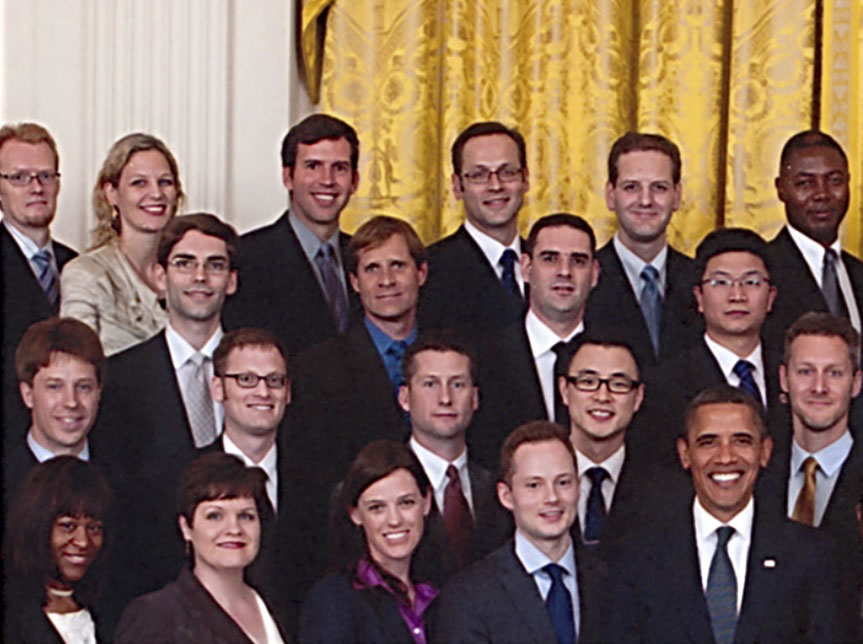
Carla Pugh, PhD ’01
Carla Pugh’s frustrations with medical training led her to Stanford Graduate School of Education. She graduated four years later with a plan.

Education makes for strong medicine: Alumna’s simulation devices transform how physicians learn their profession
Carla Pugh’s frustrations with medical training led her to Stanford Graduate School of Education. She graduated four years later with a plan.
By Joyce Gemperlein
There are many ways to describe Carla Pugh MD, PhD ’01 — surgeon, dreamer, team builder, medical professor, technology geek — but perhaps the best is this: educator. Pugh’s innovative work with sensors and human–computer interactions is revolutionizing how physicians learn to practice medicine.
Over the last two decades, Pugh has developed at least 15 devices that provide medical students with lifelike training experiences and also enable instructors to capture measurable data to better assess their students’ skills. Pugh’s pelvic examination simulator, for instance, is used in more than 200 medical and nursing schools. In addition, a dozen of her simulation-based clinical exam courses and accompanying teacher-training courses and curricula are used around the world.
“She is an out-of-the-box thinker, a pioneer, one of the most creative people I know and one of the very few people in the world who have the expertise to do this kind of work,” said Paulo Blikstein, assistant professor of education who has worked with Pugh on projects.
It was not surprising, then, to Blikstein and other colleagues and friends when they heard that Pugh is one of three alumni who will receive the inaugural Stanford Graduate School of Education Alumni Excellence in Education Award, which celebrates outstanding commitment to transforming education. The dean, faculty and a committee of leading alumni selected the winners from a pool of candidates nominated by their GSE peers.
Pugh, along with Helen Kim ’92, MA ’93, and Jonathan Jansen, PhD ’91, will be honored at an Oct. 23 reception during Reunion Homecoming Weekend. The second physician to receive a PhD from the GSE, Pugh is a professor and vice chair of education and patient safety in the Department of Surgery at the University of Wisconsin School of Medicine and Public Health. She also is clinical director of the UW Health Clinical Simulation Program.
Pugh's work draws from many disciplines, bringing the study of education and learning science into medicine. Her research has led to new ways of using technologies, most notably simulations, to teach doctors best practices. It is at the forefront of a radical change that is enabling doctors to get hands-on experience — without putting patients at risk. And it relies on the insights she gained as a doctoral student in education at Stanford.
Development of the ‘e-pelvis’
Pugh’s interest in medicine and education began early in life.
In kindergarten she regularly operated on her dolls and stuffed animals and took household appliances apart. In junior high school, she loved futuristic movies and the cool gadgets in those films. An early role model was her grandmother, who was a veterinarian and midwife. In 9th grade, Pugh narrowed her aspirations to surgery.
After receiving her BA in neurobiology from the University of California, Berkeley, in 1988, she went on to medical school, internship and residency at Howard University. A tactile and visual learner, Pugh was shocked to find that medical studies had somehow been left behind; many other fields, including professional athletics, the merchant marine and commercial aviation, were already integrating all manner of simulation devices into education.
Her studies in medical school revolved around pen, paper and tests of cognitive and declarative knowledge even though surgery and patient exams rely upon a doctor’s touch and dexterity.
Pugh said that she realized that the best way to improve medical care was to improve how doctors are trained, and she decided that the best way to do that was to “learn about learning — about curriculum, about assessment — in a structured way,” she said. In 1997 she enrolled in the doctoral program in Curriculum Studies and Teacher Education at the GSE and graduated in 2001.
Pugh said she was drawn to the GSE because of its extremely collaborative, open-minded and creative faculty and students.
She credits the late Elliot Eisner, the renowned Stanford professor of education and of art, as instrumental in her education in qualitative research, “which is one of the biggest things I came away with from my time at the Stanford GSE.”
Eisner and Myron (Mike) Atkin, professor emeritus and former GSE dean, gave her a strong foundation and starting point for looking at surgical and medical education, she said.
“I learned how to analyze data and ask hard questions from Rich Shavelson (a former dean of the GSE and professor emeritus), and,wow! My independent study with professor Larry Cuban (who examines the role of technology in education) was fantastic. He taught me how to look at the hidden curriculum and how it plays a role in learning.”
For one of her first projects in a human computer interactions course at Stanford, Pugh used plastic cling wrap, empty toilet paper rolls, Play-Doh and badminton birdies to create a prototype for a clinical exam model. A goal of the presentation was to have an idea good enough to persuade a classmate to abandon his or her idea and instead come to work with Pugh on her project. She succeeded.
Shavelson described Pugh as being uniquely able to engage everyone around her enthusiasm. “She is just dynamite,” he said.
Her dissertation was entitled “Evaluating Simulators for Medical Training: The Case of the Pelvic Exam Model.” It led to the development and patenting of the “e-pelvis,” a desktop simulation device that uses sensory technology to measure and categorize the location and intensity of the touch of medical students practicing pelvic examinations.
There was another milestone for Pugh during her time at the GSE: She met her husband-to-be, Joseph Towles, PhD ’03, now on the faculty of the Department of Biomedical Engineering at University of Wisconsin. At the time, he was pursuing his doctorate at Stanford and was presenting a paper at a symposium that Pugh had helped to organize in 2001.
Pugh’s Stanford experience played a critical role in her thinking: She gained respect for the benefits of treating education as a discipline in its own right, and she read the works of many of the giants of the field. In discussing her work today, she cites one of them — the late Ralph Tyler, who is known as the father of educational evaluation and assessment and was on the GSE faculty.
“He wrote that those who seek to make changes in education must make it a lifelong endeavor,” she said. “They must also realize that to make changes you must recognize and respond to the history of education and how it is ingrained in everyone’s experience.
“It is a rookie mistake to aspire to change systems without honoring long and rich histories of successes and failures.”
Medical education from a fabric store
Everyday objects play a large role in Pugh’s inspirations.
So does collaboration. It often includes medical researchers, engineers and techies, but she goes to some surprising sources to find new ideas.
She and her researchers are frequent visitors to hobby shops looking for items that can stand in for parts of the human body or abnormalities. They use clay balls for breast tumors. Lentils from the grocery store perfectly mimic the granules in breasts that can mask cancerous lumps.
She shopped at a fabric store with an expert in the textile industry to figure out how to devise sims for surgical procedures.
During testing at her research lab, they nixed using certain types of silk because it dulls scalpels. A fusible iron-on bonding tape (Stitch Witchery) widely available in sewing stores helped fuse layers of fleece, silk, polyester, burlap, mesh and skin-colored felt into faux abdominal walls and organs.
The result — essentially cloth boxes — are now used in continuing medical education courses to train surgeons to perform hernia repairs, pancreatic cancer procedures and tumor removals from colons or intestines and more.
Pugh’s collaborator in the venture wasn’t a physician or educator but an old friend “who I knew was up for an adventure.”
It’s emblematic of Pugh’s overall approach. She describes herself as “wanting to hang out with people who are continuously curious, who are experts in what I am curious about. Even if I think I have the best idea on the face of the earth, I won’t proceed unless we have the right team working together” she said.
Blikstein remembers being energized by such an atmosphere of ingenuity and adventure when he worked with Pugh and others in research groups. “She presents interesting research challenges while promoting harmony, participation and respect for others’ ideas and experience,” he said.
She has mentored students, particularly female and underrepresented groups, throughout her education and career. She is a prominent member of the Association of Women Surgeons and the Society of Black Academic Surgeons, which both promote social justice and advocate for marginalized populations. She was named to the President’s Council of the Museum of Science and Industry in Chicago for inspiring children to pursue careers in science, technology, medicine and engineering.
Stepping off the beaten path
Along with her career in higher education, Pugh served for two years as special assistant to the director of the Telemedicine and Advanced Technology Research Center of the U.S. Army Medical Research and Material Command at Fort Detrick, Md.
She is continuing her association with the military with a project for the U.S. Department of Defense that examines the decay of various skills of doctors sent to war, where they largely practice trauma medicine. Pugh and her team are finding ways to identify which component of returning doctors’ technical skills might need remediation.
“I think this could be applied to any profession where a combination of decision making on the fly and procedural steps are used. Obviously military pilots come to mind, but so does a classroom. We need to know more about how school teachers, after taking time off, get back their ability to, say, integrate a gifted child into the classroom, deal with unpredictable environments and so on.”
Pugh’s contributions to education are underscored by a National Institutes of Health Presidential Early Career Award for Scientists and Engineers. The award, presented by President Barack Obama in 2011, was directly related to her research on a sensor device that judges whether doctors are performing breast cancer exams correctly. It not only allows physicians and medical students to practice the exams, but also — perhaps more importantly — provides instructors with data about the amount of pressure the students are applying and how successful they were in finding and identifying potential tumors. Pugh holds a "method patent" on the use of sensor and data acquisition technology to measure and characterize the sense of touch.
In 2013, Pugh was elected to the American Surgical Association, one of the most prestigious organizations for surgeons in the world. She was also elected to the editorial board of the American Education Research Association Journal.
For the last three years, she has been in charge of education at the $6-million, 6,500-square-foot UW Health simulation facility. Under her direction, the simulation program trains physicians, nurses and emergency responders in a setting that recreates operating suites, hospital rooms and trauma centers.
The GSE’s Alumni Excellence in Education Award is the latest of the many awards she has received, and it is unique among her accolades. It recognizes how her accomplishments in medical education affect how people learn across disciplines, professions and walks of life. Stanford gave her the ability to “wake up every day excited about impacting medical education,” she said. So the award has special meaning to her.
When she was notified of her selection, “tears came to my eyes ... because it honors the courage to step out onto a not-so-easy track and do something different, ” she said. “It is high praise from my colleagues in education: It is learned people saying ‘Well done, you!’”
Joyce Gemperlein, a freelance writer in the Bay Area and a former Knight Fellow at Stanford, is a contributor to the Educator, the online newsletter of Stanford Graduate School of Education. Please read our previous issues and subscribe.
All photos are courtesy of Carla Pugh.






